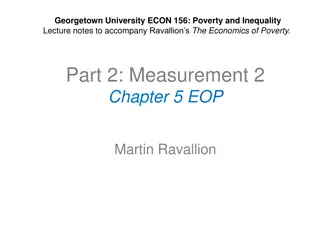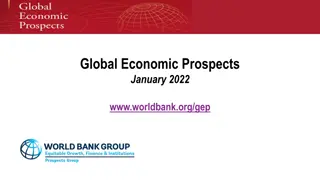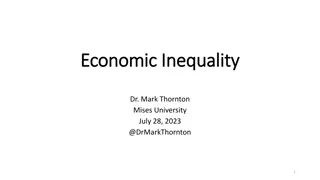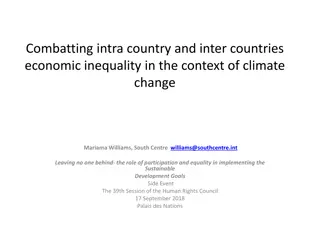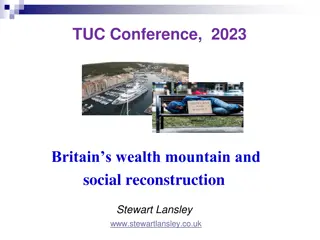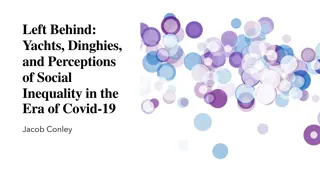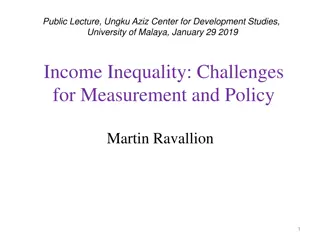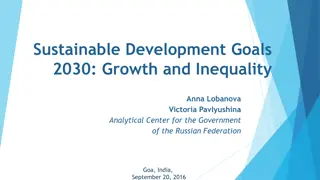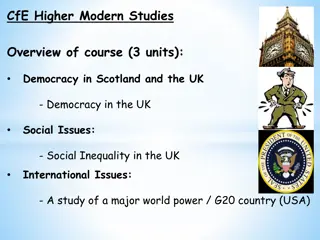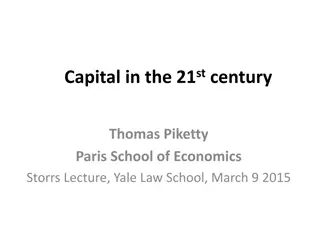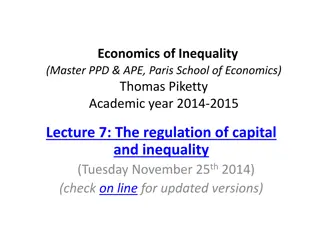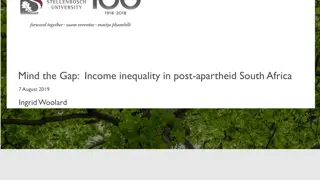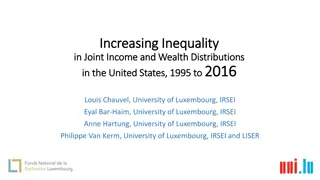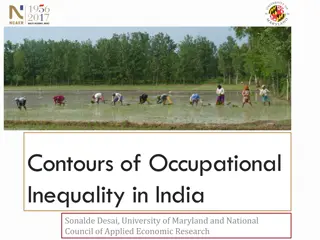Understanding Economic Development and Inequality
Economic development, indicators, and causes of uneven development are explored in this knowledge organiser. It covers concepts like GNI, HDI, demographic transition, population pyramids, colonialism, key terms, and consequences of uneven development. Strategies for reducing the development gap and the role of TNCs are also highlighted.
Download Presentation

Please find below an Image/Link to download the presentation.
The content on the website is provided AS IS for your information and personal use only. It may not be sold, licensed, or shared on other websites without obtaining consent from the author. Download presentation by click this link. If you encounter any issues during the download, it is possible that the publisher has removed the file from their server.
E N D
Presentation Transcript
Key Term Definition GCSE Knowledge Organiser Paper 2 The Changing Economic World 1 Economic To do with money (e.g. jobs, income). 2 Development The level of wealth and quality of life in a country. 2. Development indicators These indicate how developed a country is. Indicators include: - Access to safe water - Birth rate - Death rate - GNI - Infant mortality rate - Life expectancy - Literacy rate - HDI One limitation is that they are averages. 1. Classifying countries World Bank: Based on GNI per capita. - HICs: GNI per capita >$12,746 - LICs: GNI per capita <$1,045 Human Development Index (HDI) Scores countries between 0 and 1 measuring social and economic factors. 3 Development gap The difference in development between more wealthy and less wealthy countries. 4 GNI (Gross National Income) The value of a country s goods and services. Per capita means divided by the number of people ( per person ). 5 Infrastructure The basic facilities needed for a place to function e.g. roads, power supply, buildings. 3. Demographic Transition Model Shows a country s population change over time and birth rate (BR) / death rate (DR). Stage 1: BR and DR high and fluctuating. Stage 2: BR high, DR falls. Stage 3: Both BR and DR fall. Stage 4: BR and DR low and fluctuating. Stage 5: BR drops below DR. 4. Population pyramids A graph showing amount of males and females in each age group. Wide base = high birth rate Narrow apex (top) = high death rate Stages 1 and 2 have concave shape. Stages 4 and 5 have convex shape. 6 Standard of living The level of wealth, comfort, material goods and necessities available. 7 Quality of life The extent to which a person is comfortable, happy and satisfied with their life. 8 Colonialism The practice of taking full control of another country, occupying it with settlers and exploiting it economically. 9 Commercial Done for profit, typically large scale. 5-6. Causes of uneven development Physical causes: - Being landlocked means no access to trade by sea, e.g. Ethiopia. - Tropical climate means more disease spread by pests, e.g. mosquitos carrying malaria. - Extremeweather causes costly damage to infrastructure, e.g. tropical storms. - Lack of cleanwater harms health and hinders farming. Historical causes: - Colonialism: many countries natural resources stolen by others, e.g. in Europe. Slaves taken, helping to build many European economies. - War: very costly and damaging, can be a result of past colonisation or other factors. Economic causes: - Trade: N America and Europe dominate world trade, Asia is also growing in importance. They pay less for resources from less developed countries. This makes wealthy countries wealthier and hinders development in less wealthy countries. - Debt: Some countries are in debt to others, preventing investment in development. 10 Raw materials Materials in their natural state, before they are processes or used in manufacturing. 11 Refugee A person who has been forced to leave their home, usually due to war or persecution. 12 Deprived People or areas that do not have the things considered essential, e.g. healthcare. Exam style questions Outline how development indicators such as GNI can have limitations. (2 marks) Explain two causes of uneven development. (4 marks)
Key Term Definition GCSE Knowledge Organiser Paper 2 The Changing Economic World 13 Exploiting To take advantage of another person or country for personal gain. 14 Corruption People in positions of power or authority acting dishonestly for personal gain. 7-8. Consequences of uneven development International migration: People migrate to improve quality of life. Middle East Refugee Crisis: Since 2011, 100,000s of refugees have fled Syria due to war. Development of Syria has suffered. Economic migration to the UK: Many people migrate to the UK for employment. Migrants benefit the economy through taxes paid. Disparities (differences) in wealth and health: Lower levels of development tends to lead to lower wealth. Better healthcare means people in developed countries live longer than those in less developed countries. There is lots of inequality within countries. 15 Primary sector Producing raw materials and food, e.g. farming, mining. 16 Secondary sector The manufacturing sector, converting raw materials into products, e.g. cars. 17 Tertiary sector Involving the selling of services and skills, e.g. doctor, teacher, banker. 18 Quaternary sector Industries providing information services, such as ICT and research & development. 9-10. Strategies for reducing the development gap 19 TNC Transnational corporation - A large company that operates in several countries. 1. Aid: Resources given by one country to another. Can reduce development gap if long term but can be wasted by corruption. 2. Debt Relief: Reducing a country s debt means more money for development, there may be conditions attached. 20 Industrial Revolution The large-scale opening of factories in UK towns and cities in the 18th Century. 3. Fairtrade: An organisation helping farmers get fair pay. This improves quality of life, though products can cost more. 4. Industrial development: Building factories and power plants. Can create a multiplier effect, but more pollution. Post-industrial economy 21 An economy which is mainly based on jobs and money made from the tertiary and quaternary sectors. 5. Investment: Spending money on infrastructure and businesses in another country. Profits go to the investing country. 6. Intermediate Technology: Affordable equipment e.g. water pumps. Improves quality of life but may need new skills. 22 Sustainable Meeting the needs of the present, without compromising the needs of the future. 23 Globalisation The process by which businesses start operating globally and the world becomes more connected 7. Microfinance Loans: People receive smalls loans from banks. People can start a businesses, but the loan needs to be repaid. 8. Tourism: People visit a place and spend money there. Creates jobs, but too much tourism is an issue. Exam style questions With reference to a case study of an LIC or NEE, to what extend to the advantages of TNCs outweigh the disadvantages. (9 marks) With reference to an example, explain how modern industrial development in the UK can be made more sustainable. (6 marks) 11. Example: Reducing the development gap in Jamaica Jamaica is popular with tourists, boosting taxes and employment. Economy: Tourism contributed $3.3 billion to Jamaica in 2018. Employment: Tourism created jobs for 200,000 people in Jamaica. Infrastructure: Investment on the north coast, e.g. in Trelawney. Quality of life: Some improvement but many still have poor housing and limited services. Environment: Mass tourism causes waste, erosion and pollution.
Nigeria: A case study of an NEE 17. International aid in Nigeria Despite rapid economic growth, many people in Nigeria are still poor with limited access to services like clean water and sanitation. Nigeria receives about 4% of Aid given to Africa, about US$5 billion. Impacts: - Nets for Life provides anti-mosquito nets to reduce disease. - Support for development and businesses reduces reliance on oil. - Corruption has reduced effectiveness of some aid. - ActionAid has improved access to education for girls. 12. Location and importance Location: West Africa. Global importance: World s 30th largest economy (2016). Supplies 2.7% of world s oil, 5th largest contributor to UN peacekeeping Regional importance: Highest GNI and population in Africa. Nigerian music popular across Africa. Lots of natural resources, e.g. oil and rubber. 13. Nigeria s context Political: Was a British colony, independent in 1960. Power struggles and civil war from 1967-70. Fair elections in 2011 and 1015. Social: Many faiths, including trad African religions. Igbo in the south rebelled in 1967. Inequality causes new cultural tensions. Cultural: Nollywood is a major film industry. Successful Nigerian football team, winning African Cup of Nations many times. Environmental: South is tropical, north is desert. Southern grassland used for farms, forest used for cocoa, palm oil and rubber. 18. Environmental impacts of development Industrial growth caused dumping of pollutants in drains and rivers. 70-80% of Nigeria s forests destroyed (logging, agriculture, etc.) Urban growth has led to more traffic and emissions. Green belts are being built on and much vegetation is replaced by concrete. Commercial farming has caused land degradation, water pollution, soil erosion and deforestation, causing loss of species. Mining: Tin mining has caused soil erosion and release of toxic chemicals into water supplies. Oil spills in Niger Delta have been disastrous for ecosystems and local people, e.g. Bodo oil spills. 15. TNCs in Nigeria About 40 TNCs operate in Nigeria, e.g. Shell. Shell has been there since 1936. Positives: Shell pays lots of taxes and employs 65,000. 91% of contracts given to Nigerian companies. Negatives: Oil spills cause pollute water and soil. Farming and fishing have suffered. Conflict over oil has been very costly. 16. Nigeria and the wider world Political: Since independence, Nigeria joined the Commonwealth. It is also part of the UN, OPEC and The African Union. Trading: - Exports include petroleum, natural gas, rubber and cocoa. - Imports are refined petroleum, cars, phones, rice and wheat. - Australia and Indonesia are the main customers of Nigerian cotton. 14. Changing industrial structure Primary: Declining due to increasing use of machinery. Secondary: Increasing due to industrialisation. Tertiary: Increasing, e.g. retail and finance. Quaternary: Increasing, one of the fastest growing sectors. Impacts: Better income means Nigerians buy more Nigerian goods, boosting industry further. More taxes add to multiplier effect. 19. Quality of life Nigeria s HDI has steadily increased since 2005. Most development indicators are improving. Many are still poor, with limited services. The gap between rich and poor has widened, 60% live in poverty. Nigeria s dependence on oil may be a problem in the future. Tensions between cultural groups continue to be an issue.
The UKs economy 20. The changing UK economy Pre-1800, most worked in farming or mining. Industrial revolution boosted manufacturing. Now most work in services and retail. - Deindustrialisation caused decline in secondary industries e.g. shipbuilding. - Globalisation causes secondary decline as products were imported; boosted quaternary. - Government polices have changed over time. Now aim is to redevelop manufacturing. 23. Industry and the environment Industry causes air, water and soil pollution. Waste goes to landfill. Strict targets and new technology, e.g. desulphurisation, reduces impacts. Torr Quarry in Somerset is an example of more sustainable industry. Here, waste rock chippings are used for roads. Trees and lakes are used to blend in with the landscape and create habitats. 25-26. Changing transport infrastructure Roads: In 2014, a 15 billion road investment strategy was announced. Motorways have been expanded and smart motorways have been created. These help to manage traffic. Railways: Many new developments, including HS2. This will link London, Birmingham and Manchester. Travel from Birmingham to London will be <1 hour. Ports: These have about 22 million international passengers each year. Liverpool2 is new port, phase 1 completed in 2016. Costing 400 million, >5,000 jobs have been created. Airports: Important for international links, aviation provides around 500,000 jobs. Heathrow airport had expansion plans, this has been contested due to environmental concerns. 24. Changing rural landscapes Population growth: S Cambridgeshire Population increased due to migration to the area. Impacts: Increased traffic, rising house prices. Population decline: Outer Hebrides Population declined over 50% since 1901, many left due to lack of opportunities. Impacts: School closures, services close, elderly become isolated. 21. Post-industrial economy IT has transformed the economy: - Lots of data now stored and accessed rapidly - Internet enables people to work from home. - 1.3 million now work in the IT sector. Service and finance now contributes >79% of UK s economic output. London is a major financial centre. Finance employs >2 million. Research employs over 60,000, adding over 3 billion to the economy. This sector will continue to grow in the future. 28-29 UK and the wider world Trade: The UK has important trading links with the EU, USE and China. Future relationships with the EU are uncertain. Culture: Television exports, e.g. Downton Abbey, added 1.4 billion to the economy in 2018-19. Transport: Many international links, e.g. Heathrow Airport, the 7th busiest passenger airport in the world. Electronic communication: Many communication cables pass through the UK s oceans. EU: The UK is no longer part of the EU, there is a lot more to be done in resolving our future relationship with the EU. Commonwealth: A group of countries working together to improve human rights, and social and economic development. 27. The North-South Divide The south has a higher standard of living, longer life expectancy and higher income, but also higher house prices and congestion. Why? Since 1970s, many industries e.g. ship building declined, increasing unemployment in the north. London and the SE developed rapidly with fast-growing services and finance. Strategies: NorthernPowerhouse strategy to develop northern cities. HS2 to improve connections. LocalEnterprisePartnerships (LEPs) bring councils, businesses and universities together to encourage business. Enterprise Zones (EZs) give financial incentives to attract businesses. 22. Science and business parks Science parks are a group of knowledge- based industries on a single site. There are over 100 in the UK, most are linked to universities e.g. University of Southampton. Business parks are areas of land occupied by a variety of businesses. They tend to be on the edge of towns and have good transport connections, e.g. Cobalt Business Park, Newcastle-upon-Tyne.



